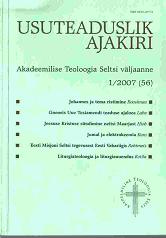Kuningas Šulgi laul: mõned märkused Uus-Sumeri kuninga Šulgi (2093–2046) kuningavõimu ideoloogia kohta
The Song of Šulgi: Some Remarks Concerning the Royal
Author(s): Vladimir SazonovSubject(s): Christian Theology and Religion
Published by: Akadeemiline Teoloogia Selts
Keywords: Ancient Near-East Studies
Summary/Abstract: This paper concentrates on the complicated question of the deification of the Neo-Sumerian king Šulgi (2093–2046 BC), the second ruler of the III Dynasty of Ur (2112–2004 BC). The founder of this III Dynasty of Ur and Neo-Sumerian kingdom, with the capital in the important Sumerian political and religious centre Ur, was the Sumerian general Ur-Namma (2112–2094). During the rule of his son Šulgi, the Neo-Sumerian kingdom became a strong and powerful state, which had probably achieved the hegemony over whole Mesopotamia and over some important city-states in Elam (located in Southern-East Iran). Nevertheless, Šulgi was not the first deified king in Mesopotamia. The first deified king attested in the archaeological sources (royal inscriptions, seal expressions and Stele of Narām-Su’en) was Narām-Su’en of Akkad (2254–2218 BC). Some years later, after death of Narām-Su’ens (ca 2218), his son Šarkališarrī (2217–2193 BC) no longer claimed divinity for himself. Šulgi restored the cult of the deified kings in Mesopotamia. This event took place evidently in the first half of the reign-period of the king Šulgi. There were composed many royal hymns in his honour, in which he was praised as a hero and deity in his own country. He was called „divine Šulgi” and „God of all young men” etc. in inscriptions and other texts. However, in this paper we do not concentrate on all aspects of the deification of Šulgi, but on some issues, like the royal titles and epithets concerning the deification of Šulgi, and on the composition of „Song of Šulgi”. We know that after Šulgi’s death (ca 2046 BC) the following rulers in Sumer had a divine status: Šulgi’s Son Amar-Su’en, then Šu-Su’en, Ibbi-Su’en. Later also all kings of the 1st Dynasty of Isin since Išbi-Erra (2017–1985 BC) were deified.
Journal: Usuteaduslik Ajakiri
- Issue Year: 2008
- Issue No: 1 (57)
- Page Range: 84-107
- Page Count: 24
- Language: Estonian

